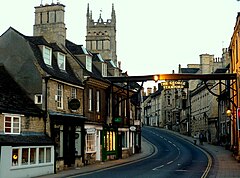Stamford, England
| Stamford | |
|---|---|
 The view from St Mary's Bridge looking up the hill towards the George Hotel |
|
 Arms of Stamford Town Council |
|
| Stamford shown within Lincolnshire | |
| Population | 19,701 |
| OS grid reference | TF0207 |
| • London | 92 mi (148 km) S |
| Civil parish |
|
| District | |
| Shire county | |
| Region | |
| Country | England |
| Sovereign state | United Kingdom |
| Post town | STAMFORD |
| Postcode district | PE9 |
| Dialling code | 01780 |
| Police | Lincolnshire |
| Fire | Lincolnshire |
| Ambulance | East Midlands |
| EU Parliament | East Midlands |
| UK Parliament | |
Stamford is a town on the River Welland in Lincolnshire, England, 92 miles (148 km) north of London on the A1. The population at the 2001 census was 21,800 including the adjacent parish of St Martin's Without.
The town has 17th and 18th-century stone buildings, older timber-framed buildings and five medieval parish churches. In 2013, Stamford was rated the best place to live by the Sunday Times.
The Romans built Ermine Street across what is now Burghley Park and forded the river Welland to the west of Stamford, eventually reaching Lincoln; they built a town to the north at Great Casterton on the River Gwash. In AD 61 Boudica followed the Roman 9th Legion (Legio IX Hispana) across the river. The Anglo-Saxons later chose Stamford as their main town, being on a more important river than the Gwash.
In 972 King Edgar made Stamford a borough. The Anglo-Saxons and Danes faced each other across the river. The town originally grew as a Danish settlement at the lowest point that the Welland could be crossed by ford or bridge. Stamford was the only one of the Danelaw Five Burghs ("boroughs") not to become a county town. Initially a pottery centre, producing Stamford Ware, by the Middle Ages it had become famous for its production of wool and the woollen cloth known as Stamford cloth or haberget - which "In Henry III's reign ... was well known in Venice".
Stamford was a walled town but only a very small portion of the walls now remain. Stamford became an inland port on the Great North Road, the latter superseding Ermine Street in importance. Notable buildings in the town include the mediaeval Browne's Hospital, several churches and the buildings of Stamford School, a public school founded in 1532.
...
Wikipedia

